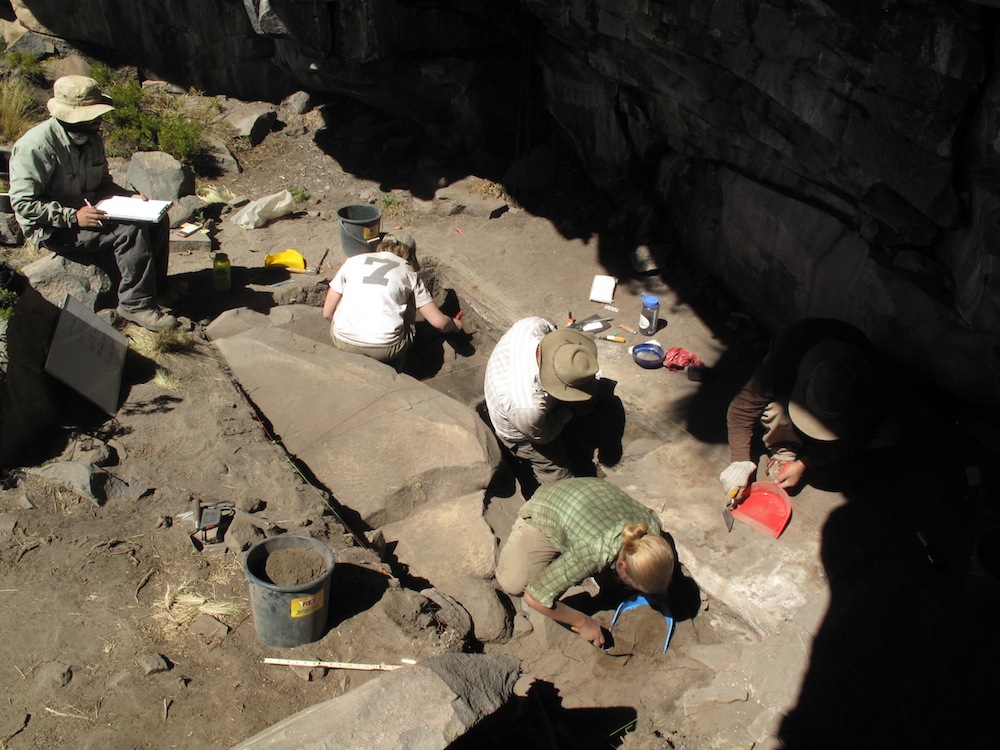
The oldest-known evidence of humans living at extremely high altitudes has been unearthed in the Peruvian Andes, archaeologists say.
The sites — a rock shelter with traces of Ice Age campfires and rock art, and an open-air workshop with stone tools and fragments — are located nearly 14,700 feet (4,500 meters) above sea level and were occupied roughly 12,000 years ago.
The discovery, which is detailed today (Oct. 23) in the journal Science, suggests ancient people in South America were living at extremely high altitudes just 2,000 years after humans first reached the continent.
The findings also raise questions about how these early settlers physically adapted to sky-high living.
"Either they genetically adapted really, really fast — within 2,000 years — to be able to settle this area, or genetic adaptation isn't necessary at all," said lead study author Kurt Rademaker, who was a University of Maine visiting assistant professor in anthropology when he conducted the study. [See Images of the High-Altitude Ancient Settlement]
In follow-up work, the team plans to look for more evidence of occupation, such as human remains.
Coastal clue
Sign up for the Live Science daily newsletter now
Get the world’s most fascinating discoveries delivered straight to your inbox.
The recent discovery of these high-altitude artifacts was made possible by work that started in the 1990s. At that time, Rademaker and his colleagues were studying a 13,000-year-old Paleoindian fishing settlement on the coast of Peru called Quebrada Jaguay. There, they found tools made of obsidian, a volcanic rock. There were no rivers or other geologic forces to carry the volcanic rock to the coast, and the closest volcanoes were in the Andes Mountains, roughly 100 miles (160 kilometers) away, said Rademaker, who is now a postdoctoral researcher at the University of Tübingen in Germany.
"This obsidian told us that early on, Paleoindians must have gone to the highlands," Rademaker told Live Science.
Rademaker and his colleagues analyzed the obsidian and determined that it likely came from around the Pucuncho Basin, an arid, cold plateau ringed by 21,000-foot-tall (6,400 meters) volcanoes, Rademaker said.
High life
After years of searching around the plateau, the researchers found a rock shelter with two alcoves, ceilings blackened with soot and walls decorated with rock art. The site also showed evidence of burnt detritus from ancient people's campsites. The rock shelter was used for thousands of years, starting around 12,400 years ago, and may have been a temporary base camp where herders sheltered from the rain, Rademaker said.
The coastal obsidian point likely came from a nearby outcropping, near what would've been an ancient open-air workshop at the time, the researchers said. The workshop contained hundreds of ancient tools, from spear points to scrapers to bifaces, or hand axes, some of which dated to 12,800 years old. The researchers also found large mammal bones from vicuña, the wild ancestors to alpacas, similar animals called guanacos, and taruca deer.
It's still not clear whether the people living along the coast and in the highlands were the same individuals, or whether they maintained trading networks across large distances, Rademaker said. [In Photos: Human Skeleton Sheds Light on First Americans]
Early settlers
The findings suggest people were living at high altitudes earlier than previously thought.
"People were really settled in and using this environment at the end of the ice age around 12,400 years ago," said Michael Waters, an anthropologist at Texas A&M University in College Station, who was not involved in the study. "They were going back and forth between the coast and this high-altitude site."
People in modern culture, perhaps because of stories of pioneers going west and getting trapped in the mountains (and eating each other), tend to see the highlands as poor living environments, said Bonnie Pitblado, an archaeologist at the University of Oklahoma, who was not involved in the study.
"There was this cultural stereotype that mountains are just impediments, that they get in the way," Pitblado told Live Science. But for prehistoric cultures, "mountains are these places with just the most amazing array of resources."
For instance, the highlands may have had hot springs and ice caves, glacial melt streams and other water sources, and the rock needed for stone tools, such as quartz, chert and obsidian, Pitblado said.
The findings also call into question just what is needed for people to live in high altitudes. At those locations, the air is much cooler and thinner, meaning it holds less oxygen than lower elevations. So, past studies have found that people living at high elevations have genetic adaptations that help them efficiently use oxygen from the thin mountain air, as well as mutations that can shield them from heart disease and strokes caused by chronic mountain sickness.
But the current research suggests that either people evolved these adaptations in just a few thousand years, or that these mutations weren't necessary for the first inhabitants.
After all, lowlanders like Rademaker live at high elevations all the time and do just fine, he said.
Follow Tia Ghose on Twitterand Google+. Follow Live Science @livescience, Facebook & Google+. Originally published on Live Science.

Tia is the managing editor and was previously a senior writer for Live Science. Her work has appeared in Scientific American, Wired.com and other outlets. She holds a master's degree in bioengineering from the University of Washington, a graduate certificate in science writing from UC Santa Cruz and a bachelor's degree in mechanical engineering from the University of Texas at Austin. Tia was part of a team at the Milwaukee Journal Sentinel that published the Empty Cradles series on preterm births, which won multiple awards, including the 2012 Casey Medal for Meritorious Journalism.









